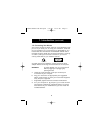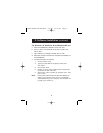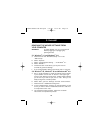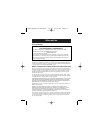
6
3. Troubleshooting (continued)
These steps have taken you to the "Control Panel" where
you can gain access to your "Device Manager". The "Device
Manager" shows your driver status and information and it
will allow you to modify their settings.
After entering the "Control Panel" use your "Up" and
"Down" arrows to select "System", and then press "Enter".
After entering "System Properties" use your "Right” arrow
to select "Device Manager". Then press "Tab" until you have
selected "Computer" and then use the "Down” arrow until
your "Mouse" is highlighted. Then use your "Right” arrow to
expand and select your mouse driver or drivers. After you
have chosen your mouse driver you can now modify it by
removing the driver or changing the driver.
To remove the driver you have selected, use your "Tab" key
until the "Remove" tab is selected. Then press "Enter". This
will remove the driver. Use your "Arrow” keys to select any
other drivers and repeat the process until all but one driver
remains. Even if it is the wrong driver you can use it and
change it to the mouse driver you want.
After removing or changing the mouse driver, use your
"Tab" key until "Close" is selected and then press "Enter".
Then you will have to reboot your computer. Use your
"Windows
®
" key at the bottom left hand corner of your
keyboard if you have one; if not, press "Alt + S". Then use
the "Up” arrow to select "Shut Down" and press "Enter".
Use your "Arrow” key to select "Restart" and press "Enter".
Q: After installing the mouse driver and rebooting, my
mouse will not work. How do I change the mouse driver
without mouse control?
P73096-F8E201-US-man-qxd 3/9/00 8:14 AM Page 6


















